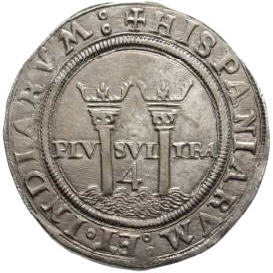Crowned pillars standing in water
4 reales from Mexico
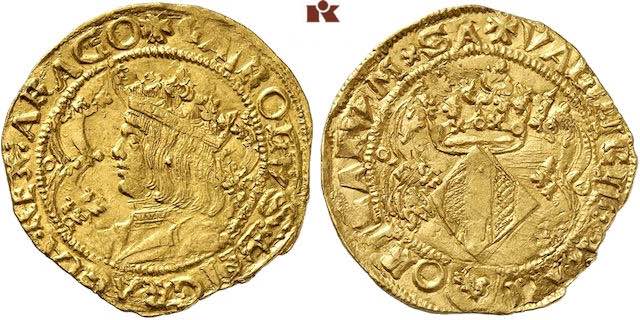
Doble ducado (double ducat) n. d., Valencia. Ø 27 mm 7,03 g. Calicó 8; Friedb.91. Obv.: +CAROLVS·DEI·GRACIA·REX·ARAGO - crowned bust surrounded by gothic ornament. Rev.: +VALENCIE·MAI - ORICARVM·SA - crowned arms of Valencia surrounded by ornament. Compare the Valencian ducat n. d. (after 1504) of Ferdinand the Catholic  with similar bust. with similar bust.
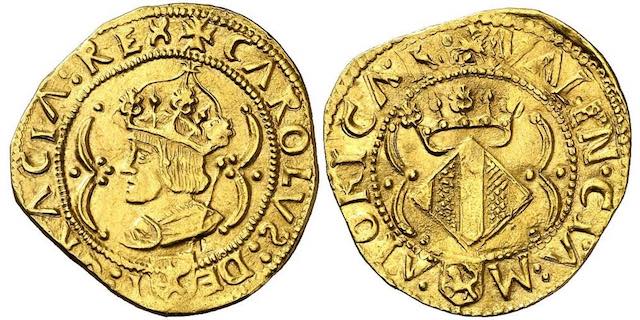
Doble ducado (double ducat) n. d., Valencia. Ø 27 mm, 6,97 g. +CAROLVS:DE - I:GRACIA:REX // VALEN·CI·A:M - ·AIORICA·R
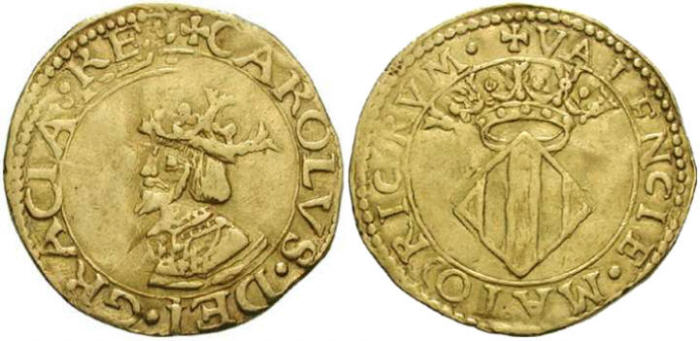
Doble ducado (double ducat) n. d. (before 1539), Valencia. Ø 27 mm, 6,98 g unique. Obv.: +CAROLVS·DEI·GRACIA·RE· - crowned bust without gothic ornament. A restrike displaced RE in the upper left onto the X of REX and opened the inner circle to a spiral. Also the front prong of the crown was lost (flattened) by the restrike. Note the strange disturbing dot in the emperor's eye in the center of the coin. This lamentable central dot is not part of the designed picture ! Rev.: +VALENCIE·MAIORICARVM· - crowned arms of Valencia without side-ornaments.
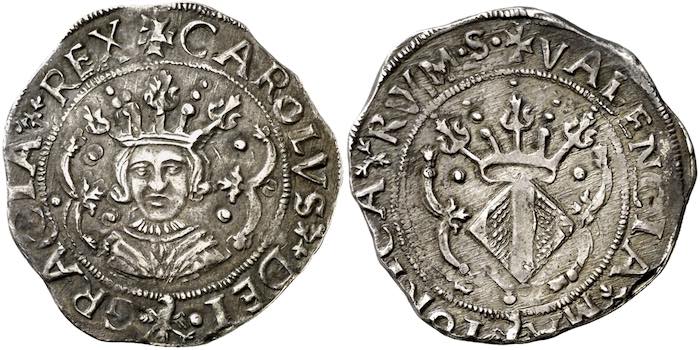
4 reales n. d., Valencia. Ø 33 mm, 10,20 g. Cru.C.G. 4147e. Obv.: +CAROLVS⁂DEI GRACIA⁂REX - crowned bust en face. Rev.: +VALENCIA⁂MA - IORICA⁂RVM·S· - crowned arms of Valencia.
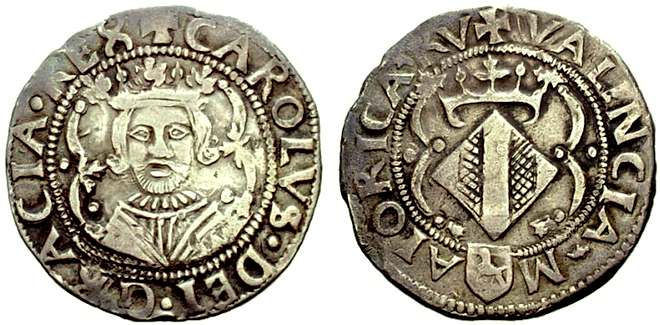
2 reales n. d., Valencia. Ø 28 mm. Cy.3218. Obv.: +CAROLVS·DEI·GRACIA·REX - crowned bust en face. Rev.: +VALINCIA·M (shield with lion) AIORICA·RV - crowned arms of Valencia. This medieval bust was used almost unchanged in Valencia from initially on the Real of Martín I (1396-1410)
 up to the 17th century. up to the 17th century.
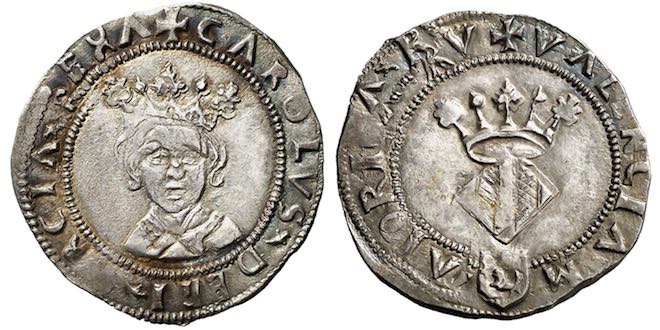
Real n. d., Valencia. Ø 24 mm, 2,67 g. +CAROLVS·DEI·GRACIA·REX // +VALENCIA M - AIORIARV (Doppelschlag auf beiden Seiten) Here on both sides exceptionally without framing multipass. In the Middle Ages there was a preference to avoid empty spaces.
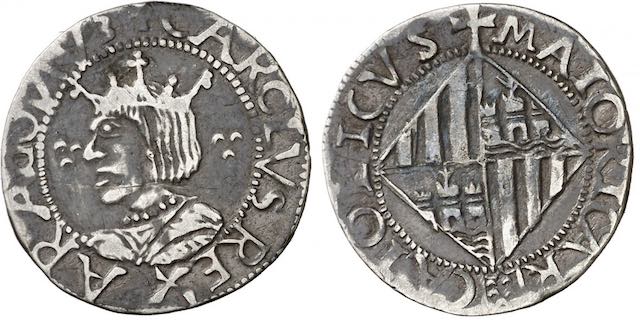
Real n. d., Palma de Mallorca. Ø 22 mm, 2,22 g. Cal.43; Cru.C.G. 4128. +CAROLVS REX ARAGONV Bust lefts. // MAIORICAR - CATOLICVS Arms of Mallorca.
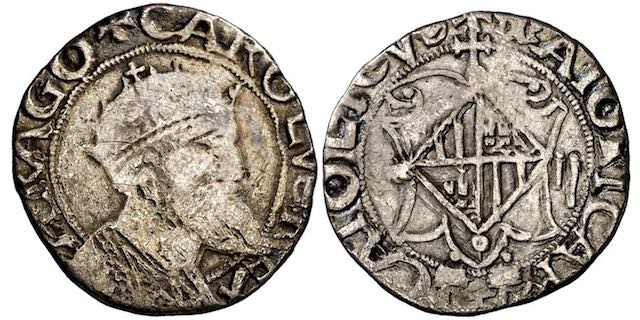
2 reales n. d., Palma de Mallorca. Ø 26 mm, 4,27 g. Cal.c. 30; Cru.C.G.c. 4125. CAROKVS REX - ARAGO // MAIOACAM - CATOLICVS
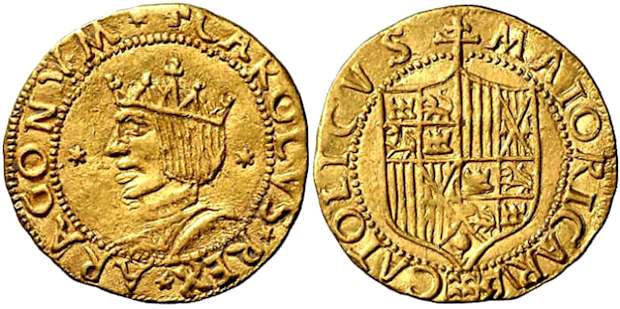
Ducado n. d., Palma de Mallorca. Ø 21 mm, 3,36 g. Cayón 3241; Calicó/Trigo 35; Friedb.54. Obv.: +CAROLVS·REX·ARAGONVM· - crowned bust between two stars. Rev.: ‡MAIORICARV3 (arms) CATOLICVS - shield: Castile|León, Aragón|Sicily and Granada.
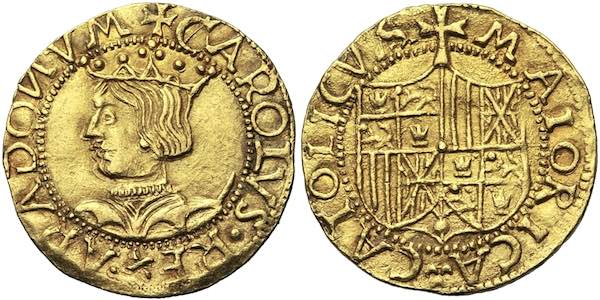
Ducado n. d., Palma de Mallorca. Ø 21 mm, 3,47 g. C.C.T. 33; Friedb.54. Obs.: +CAROLVS·REX·ARAGONVM (G & N mirror image) - crowned bust to the left. Rev.: MAIORICA (mm.) CATOLICVS - Wappen wie vor.
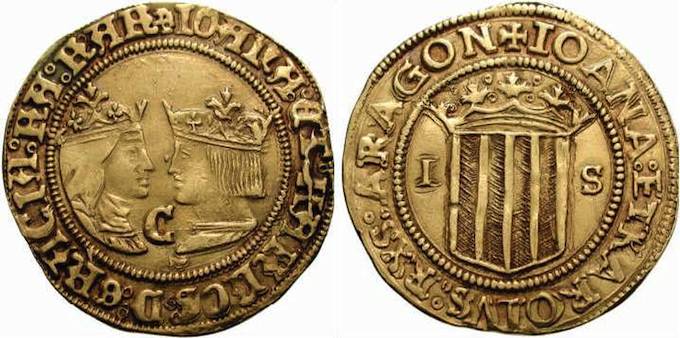
Doble ducado (double ducat) n. d., Zaragoza. Ø 26 mm. Friedb.22. Obv.: + IOANA:ET:KARLOS:D:GRACIA:RA:BAR - Legend in gothic letters (die from about 1520). Crowned busts of Joanna and Charles facing each other, between them: C (mint Zaragosa). Rev.: + IOANA:ET KAROLVS:RXS:ARAGON. - Legend in Latin antiqua letters (die after 1525), crowned arms of Aragón between L - S (mint master Luis Sánchez de Calatayud).
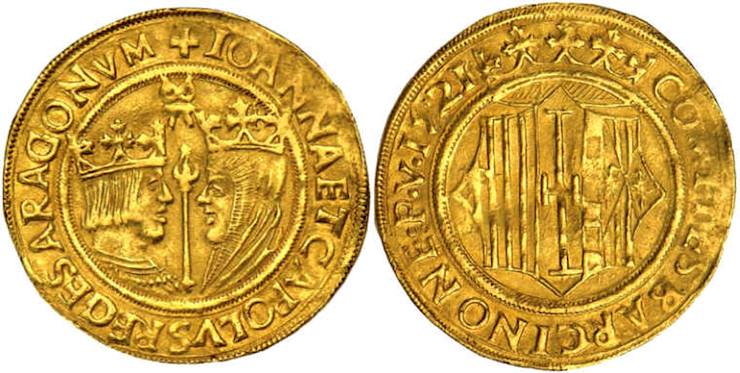
2 Principats (double ducat) 1521, Barcelona. Ø 28 mm, 6,9 g. Cayón 1459; Friedb.35. Obv.: +IOANA ET CARLOLVS REGES ARAGONVM Crowned busts of Charles and Joanna, between them a scepter, above them a firesteel on a St. Andrew's Cross, unusual symbol in Spain. Rev.: COMITES BARCINONE·P·V·1521 "Earls of Barcelona" Crown in the legend above the divided arms of Aragón and Naples (Jerusalem|Hungary|Sicily). The arms of pretension of Jerusalem originate with Charles I of Anjou, King of Naples 1266-1285.
Compare the double ducat 1521 from Barcelona
 of the coin cabinet of the Bode-Museum in Berlin. of the coin cabinet of the Bode-Museum in Berlin.
The Bibliothèque nationale de France, Dép. des Monnaies, is in possession of an unique show piece:
100 ducats 1528, Zaragoza LS  (Ø 84 mm, 349,32 g). (Ø 84 mm, 349,32 g).
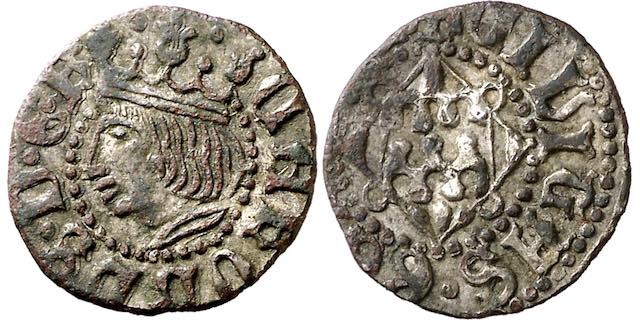
Dinero n. d. (1528), Gerona. Ag250 Ø 14 mm, 1 g. CARLOLVS·D·G·R head left // CIVITAS GERVNDA (T like tau) arms. The "dinero" (lat. denarius) was the smallest denomination.
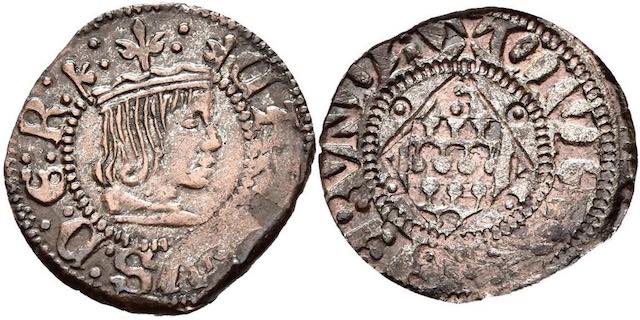
Dinero n. d. (1553), Gerona. AE Ø 16 mm, 0,96 g. Cal-2019-6. Obv.: CARLOLVS:D:G:R: - crowned head to the right. Rev.: +CIVITAS GERVNDA - G over coat of arms in square surrounded by squiggles.
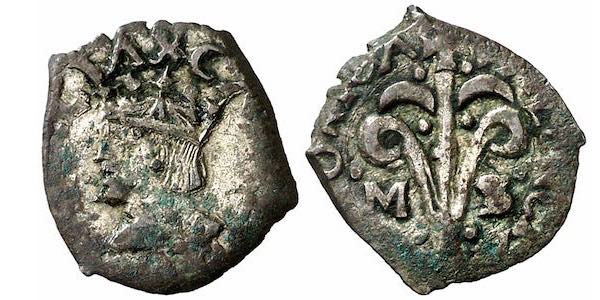
Dinero n. d. Valencia. AE Ø 15 mm, 0,89 g. Cal.79; Cru.C.G. 4156. Ref.:
|
 start page
start page